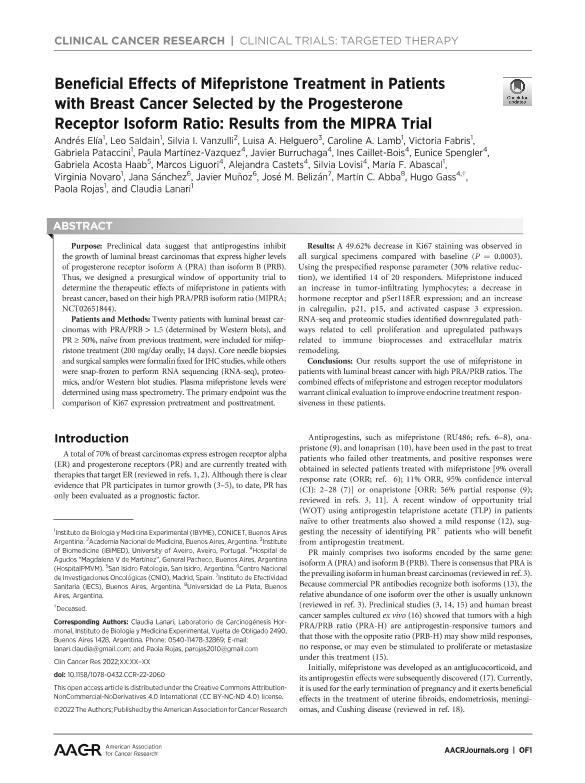Artículo
Beneficial Effects of Mifepristone Treatment in Patients with Breast Cancer Selected by the Progesterone Receptor Isoform Ratio: Results from the MIPRA Trial
Elia, Andres Maximiliano ; Saldain, Leo; Vanzulli, Silvia; Helguero, Luisa Alejandra; Lamb, Caroline Ana
; Saldain, Leo; Vanzulli, Silvia; Helguero, Luisa Alejandra; Lamb, Caroline Ana ; Fabris, Victoria Teresa
; Fabris, Victoria Teresa ; Pataccini, Gabriela
; Pataccini, Gabriela ; Martínez Vazquez, Paula; Burruchaga, Javier; Caillet Bois, Ines; Spengler, EunicE; Acosta Haab, Gabriela; Liguori, Marcos Daniel; Castets, Alejandra; Lovisi, Silvia; Abascal, Maria Florencia
; Martínez Vazquez, Paula; Burruchaga, Javier; Caillet Bois, Ines; Spengler, EunicE; Acosta Haab, Gabriela; Liguori, Marcos Daniel; Castets, Alejandra; Lovisi, Silvia; Abascal, Maria Florencia ; Novaro, Virginia
; Novaro, Virginia ; Sánchez, Jana; Muñoz, Javier; Belizán, José M.; Abba, Martín Carlos
; Sánchez, Jana; Muñoz, Javier; Belizán, José M.; Abba, Martín Carlos ; Gass, Hugo Daniel; Rojas, Paola Andrea
; Gass, Hugo Daniel; Rojas, Paola Andrea ; Lanari, Claudia Lee Malvina
; Lanari, Claudia Lee Malvina
 ; Saldain, Leo; Vanzulli, Silvia; Helguero, Luisa Alejandra; Lamb, Caroline Ana
; Saldain, Leo; Vanzulli, Silvia; Helguero, Luisa Alejandra; Lamb, Caroline Ana ; Fabris, Victoria Teresa
; Fabris, Victoria Teresa ; Pataccini, Gabriela
; Pataccini, Gabriela ; Martínez Vazquez, Paula; Burruchaga, Javier; Caillet Bois, Ines; Spengler, EunicE; Acosta Haab, Gabriela; Liguori, Marcos Daniel; Castets, Alejandra; Lovisi, Silvia; Abascal, Maria Florencia
; Martínez Vazquez, Paula; Burruchaga, Javier; Caillet Bois, Ines; Spengler, EunicE; Acosta Haab, Gabriela; Liguori, Marcos Daniel; Castets, Alejandra; Lovisi, Silvia; Abascal, Maria Florencia ; Novaro, Virginia
; Novaro, Virginia ; Sánchez, Jana; Muñoz, Javier; Belizán, José M.; Abba, Martín Carlos
; Sánchez, Jana; Muñoz, Javier; Belizán, José M.; Abba, Martín Carlos ; Gass, Hugo Daniel; Rojas, Paola Andrea
; Gass, Hugo Daniel; Rojas, Paola Andrea ; Lanari, Claudia Lee Malvina
; Lanari, Claudia Lee Malvina
Fecha de publicación:
11/2022
Editorial:
American Association for Cancer Research
Revista:
Clinical Cancer Research
ISSN:
1078-0432
Idioma:
Inglés
Tipo de recurso:
Artículo publicado
Clasificación temática:
Resumen
Purpose: Preclinical data suggest that antiprogestins inhibit the growth of luminal breast carcinomas that express higher levels of progesterone receptor isoform A (PRA) than isoform B (PRB). Thus, we designed a pre-surgical window of opportunity trial to determine the therapeutic effects of mifepristone in patients with breast cancer based on their high PRA/PRB isoform ratio (MIPRA; NCT02651844).Patients and methods: Twenty patients with luminal breast carcinomas with PRA/PRB>1.5 (determined by western blots), and PR ≥50%, naive from previous treatment, were included for mifepristone treatment (200 mg/day p.o.; 14 days). Core needle biopsies (CNB) and surgical samples were formalin-fixed for immunohistochemical studies, while others were snap-frozen to perform RNA-Seq, proteomics, and/or western blot studies. Plasma mifepristone levels were determined using mass spectrometry. The primary endpoint was the comparison of Ki67 expression pre- and post-treatment.Results: A 49.62% decrease in Ki67 staining was observed in all surgical specimens compared to baseline (p=0.0003). Using the prespecified response parameter (30% relative reduction), we identified 14/20 responders. Mifepristone induced an increase in tumor-infiltrating lymphocytes, a decrease in hormone receptor and pSer118ER expression, and an increase in calregulin, p21, p15, and activated caspase3 expression. RNA-Seq and proteomics studies identified downregulated pathways related to cell proliferation and upregulated pathways related to immune bioprocesses and extracellular matrix remodeling.Conclusions: Our results support the use of mifepristone in patients with luminal breast cancer with high PRA/PRB ratios. The combined effects of mifepristone and estrogen receptor modulators warrant clinical evaluation to improve endocrine treatment responsiveness in these patients.
Palabras clave:
CÁNCER DE MAMA
,
RECEPTOR DE PROGESTERONA
,
MIFEPRISTONA
,
ESTUDIO CLÍNICO
Archivos asociados
Licencia
Identificadores
Colecciones
Articulos(CCT - LA PLATA)
Articulos de CTRO.CIENTIFICO TECNOL.CONICET - LA PLATA
Articulos de CTRO.CIENTIFICO TECNOL.CONICET - LA PLATA
Articulos(IBYME)
Articulos de INST.DE BIOLOGIA Y MEDICINA EXPERIMENTAL (I)
Articulos de INST.DE BIOLOGIA Y MEDICINA EXPERIMENTAL (I)
Citación
Elia, Andres Maximiliano; Saldain, Leo; Vanzulli, Silvia; Helguero, Luisa Alejandra; Lamb, Caroline Ana; et al.; Beneficial Effects of Mifepristone Treatment in Patients with Breast Cancer Selected by the Progesterone Receptor Isoform Ratio: Results from the MIPRA Trial; American Association for Cancer Research; Clinical Cancer Research; 29; 5; 11-2022; 866-877
Compartir
Altmétricas



